This article needs additional citations for verification .(August 2020) |
The tirailleurs malgaches were a corps of French colonial infantry established in Madagascar.
Contents
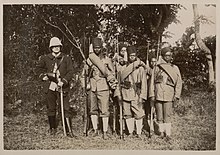
This article needs additional citations for verification .(August 2020) |
The tirailleurs malgaches were a corps of French colonial infantry established in Madagascar.

After the annexation of Madagascar by France in 1896, Malagasy troops were recruited, and the Tirailleurs malgaches were formed along similar lines to the Senegalese Tirailleurs, forming part of the Troupes coloniales of the French Armed Forces. In 1905, there were three regiments, each of three battalions apiece, stationed at Tananarive, Tamatave and Diego Suarez. [1]

During World War I, the governor general of the colony, Hubert Garbit, organised the mobilisation of the Malagasy population. The first contingent was sent in October 1915 to France, followed by five others in 1916. Like their Tirailleurs indochinois counterparts the Tirailleurs malgaches battalions were initially employed behind the lines in guard, depot and factory-worker duties, rather than being deployed in a fighting role. [2] A total of 26 battalions were formed between 1916 and 1918. These were garrisoned mainly at the camps of Fréjus and Puget-sur-Argens in the Var, and most were dissolved in 1918, with around 15,000 men being transferred to the artillery. Three battalions performed rear echelon duties with the Armée d'Orient (1915–1919) on the Macedonian front. [3] [lower-alpha 1] The 12e bataillon de tirailleurs malgaches was the only battalion to be awarded the Fourragère of the Croix de guerre 1914–1918 (France) for three unit citations. [5] Up until 22 July 1918, it formed part of the highly decorated 1st Moroccan Infantry Division.
45,863 Malagasys served in the ranks of the French Army (including 41,355 in combat roles). Of these 10,000 were incorporated into heavy artillery regiments. [6] A total of 3,101 Malagasy soldiers were killed or reported missing and 1,835 injured.
In 1926 the Malagasy units were redesignated as the 1st and 2nd regiments mixte de Madagascar. These in turn were disbanded in November 1942, following the British occupation of the island. Reformed in 1946, the RMM lost their specific Malagasy identity after 1957 when merged into the mainstream Troupes de Marine. [7]
Throughout their history the Tirailleurs malgaches wore the same dark blue or khaki uniforms as the Tirailleurs senegalais on which they were modelled. The only distinction was the substitution of the letters TM for TS on the collar patches. [8]
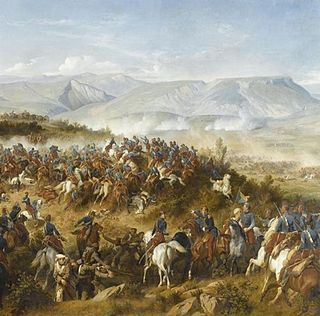
The Chasseurs d'Afrique were a light cavalry corps of chasseurs in the French Armée d'Afrique. First raised in 1831 from regular French cavalry posted to Algeria, they numbered five regiments by World War II. For most of their history they were recruited from either French volunteers or French settlers in North Africa doing their military service. As such they were the mounted equivalent of the French Zouave infantry. The other major cavalry element in the Armee d'Afrique were the Spahis—recruited from the indigenous peoples of Algeria, Tunisia, and Morocco with mostly French officers.
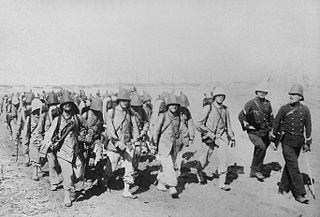
The Troupes coloniales or Armée coloniale, commonly called La Coloniale, were the colonial troops of the French colonial empire from 1900 until 1961. From 1822 to 1900 these troops were designated Troupes de marine, and in 1961 they readopted this name. They were recruited from mainland France or from the French settler and indigenous populations of the empire. This force played a substantial role in the conquest of the empire, in World War I, World War II, the First Indochina War and the Algerian War.
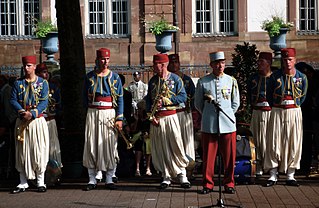
A tirailleur, in the Napoleonic era, was a type of light infantry trained to skirmish ahead of the main columns. Later, the term "tirailleur" was used by the French Army as a designation for indigenous infantry recruited in the French colonial territories during the 19th and 20th centuries, or for metropolitan units serving in a light infantry role.
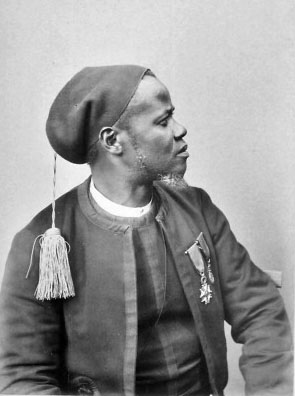
The Senegalese Tirailleurs were a corps of colonial infantry in the French Army. They were initially recruited from Senegal, French West Africa and subsequently throughout Western, Central and Eastern Africa: the main sub-Saharan regions of the French colonial empire. The noun tirailleur, which translates variously as 'skirmisher', 'rifleman', or 'sharpshooter', was a designation given by the French Army to indigenous infantry recruited in the various colonies and overseas possessions of the French Empire during the 19th and 20th centuries.
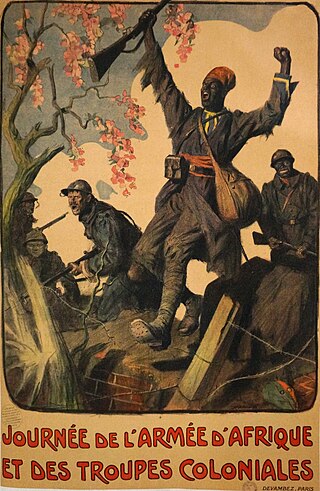
The Army of Africa was an unofficial but commonly used term for those portions of the French Army stationed in French North Africa from 1830 until the end of the Algerian War in 1962, including the French units made up of indigenous recruits.
The 72nd Infantry Division was a French Army formation during World War I.
The 19th Army Corps was a corps of the French army. In December 1870, the Tours delegation created the 19th Army Corps which was formed in Alençon. It was recreated by decree of the JO of August 13, 1874, it brought together the various military units of Algeria. It constituted the nucleus of the Army of Africa.
The Armée d'Orient (AO) was a field army of the French Army during World War I who fought on the Macedonian front.
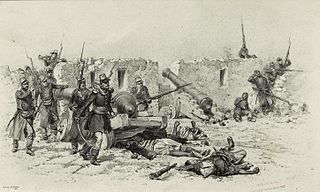
The Battalions of Light Infantry of Africa, better known under the acronym Bat' d'Af', were French infantry and construction units, serving in Northern Africa, made up of men with prison records who still had to do their military service, or soldiers with serious disciplinary records.

The Tirailleurs indochinois were soldiers of several regiments of local ethnic Indochinese infantry organized as Tirailleurs by the French colonial authorities, initially in Vietnam from 15 March 1880. The most notable, and first established, of these units were the Tonkinese Rifles.

The Corps Expeditionnaire d'Orient (CEO) was a French expeditionary force raised for service during the Gallipoli Campaign in World War I. The corps initially consisted of a single infantry division, but later grew to two divisions. It took part in fighting around Kum Kale, on the Asiatic side of the Dardanelles, at the start of the campaign before being moved to Cape Helles where it fought alongside British formations for the remainder of the campaign. In October 1915, the corps was reduced to one division again and was finally evacuated from the Gallipoli peninsula in January 1916 when it ceased to exist.
The Moroccan Division or the 1st Moroccan Division of 1914, initially the Marching Division of Morocco was an infantry division of France's Army of Africa which participated in World War I.
The Détachement Français de Palestine et de Syrie was the name given to French forces in the Middle East from 1917 onwards, within the Egyptian Expeditionary Force. Although they were commanded in the field by Colonel Gilles de Philpin de Piépape, they were overseen by General Maurice Bailloud who was the Inspector-General. The detachment arrived at Rafah on 25 May 1917.
The 31st Army Corps was a corps of the French army, created at the start of the First World War. From the date of its creation until June 1916, the army corps occupied front sectors in Lorraine. In June, the 31st Army Corps fought on the left bank of the Meuse during the Battle of Verdun. Subsequently, it occupied a front line sector in the Argonne, before being transported to the Italian Front as a reinforcement after the Italian defeat at the Battle of Caporetto, alongside the 10th Army (France). In March 1918, the army corps was redeployed to France, to face the German offensives, it was situated on the Somme front until the end of the war.
156th Infantry Division was an infantry division of the French Army during the First World War. It was deployed overseas, seeing action during the Gallipoli campaign, and thereafter on the Salonika front, fighting alongside British troops in both theatres of war. It was sent to the Crimea in December 1918 as part of the Army of the Danube.
122nd Infantry Division was an infantry division of the French Army during the First World War. It was deployed overseas, seeing action on the Salonika front, fighting alongside British troops. It was sent to the Crimea in December 1918 as part of the Army of the Danube.
57th Infantry Division was an infantry division of the French Army during the First World War. It was deployed overseas, seeing action on the Salonika front, fighting alongside British troops. It was sent to the Crimea in December 1918 as part of the Army of the Danube.

Adrien Paul Alexandre Chrétien was a French general who participated in World War I. He spent the war commanding the 30th Army Corps at throughout several battles of the Western Front.

Pierre Émile Berdoulat (1861-1930) was a French Divisional General who participated in World War I. He participated in the battles of the 2nd Champagne and the Somme before becoming the Military governor of Paris from 1919 to 1923.
17th Colonial Infantry Division was an infantry division of the French Army during the First World War. It was deployed overseas, seeing action during the Gallipoli campaign, and thereafter on the Salonika front, fighting alongside British troops in both theatres of war. It was sent to the Crimea in December 1918 as part of the Army of the Danube.

Notes
References
Pendant la Grande Guerre, plus de 41 000 Malgaches ont été recrutés par l'armée française pour combattre en Europe. La grande majorité d'entre eux seront utilisés pour les travaux de génie.
Large numbers of "Creoles", "Africans" and "Malagasy" ethnicities were incorporated into the Régiments d'Artillerie Lourde from 1917